Abstract
The proliferation of wireless networking solutions, which are omnipresent in our daily lives, has led to increased exposure to the energy of electromagnetic (EM) waves in the higher frequency range, raising concerns about their impact on human health. Investigating the propagation of EM waves through multilayer structures can shed light on the future direction of effective protection and shielding solutions. The paper provides a comparative study that examines EM wave propagation through a multilayered composite structure. The structure combines Plexiglas plates (acrylic, polymethyl methacrylate), a dielectric material, with one or more layers of conductive YSHIELD HSF54 paint to reduce EM field intensity. The paint’s carbon-based particle composition promises effective field attenuation. Our side-by-side comparative real-world measurements and simulation results showcase correlation. We further demonstrated the benefits of applying a layer of conductive YSHIELD HSF54 paint over Plexiglass to form a composite structure, with the initial layer contributing to attenuation of approximately 20 dB. Finally, the results were validated by calculating Morozov’s first- and second-order analytical approximations for the transmission parameter —the calculated values accurately trace both the simulations and measurements. The research concludes that shielding, which is used as a method of protection against EM radiation in many industrial devices, can also be used in procedures to protect human habitats by selecting new, innovative, and affordable materials and structures.
1. Introduction
Over the past few decades, and particularly in recent years, technological advancements have surged exponentially, driven by the rising demands of an ever-growing user base. These demands span diverse applications, from industrial innovations such as autonomous vehicles and robots to scientific breakthroughs in telemedicine, as well as consumer technologies like smartphones and digital cameras. This rapid proliferation of technology has profoundly reshaped societal dynamics, integrating sophisticated systems into the fabric of daily life. As radio communication networks evolve—typically requiring a decade to develop each new generation—their deployment increasingly shifts toward higher frequency bands. This shift is required not only by the saturation of lower frequency spectra, which has been systematically allocated over time, but also by the superior capabilities of higher frequencies. These include faster transmission of large data volumes, enhanced device efficiency, and compact designs that support a wide array of applications, from high-speed internet to IoT ecosystems.
However, the adoption of higher frequency ranges in mobile networks has sparked growing concerns about the potential health impacts of electromagnetic (EM) radiation. As wireless technologies have become ubiquitous, public and scientific awareness of the need for effective protection against EM exposure has intensified. This issue is a focal point for researchers worldwide, including the authors of this study, who are dedicated to understanding and mitigating the risks associated with EM radiation. The exploration of protective measures is critical, as the omnipresence of wireless devices amplifies the urgency of developing robust shielding solutions that safeguard human health without compromising technological performance.
In further sections, this paper presents a detailed analysis of how multilayered composite structures influence the attenuation of the transmission parameter . This study evaluates the performance of Plexiglas and conductive YSHIELD HSF54 paint (YSHIELD, Ruhstorf, Germany) when integrated into a circular waveguide, operating within the frequency range of 1.5 GHz to 6 GHz. Through a combination of theoretical simulations and experimental measurements, our study demonstrates the efficacy of structures in reducing EM field strength, offering insights into their potential as shielding solutions in high-frequency environments.
2. Related Work
Electromagnetic non-ionizing radiation poses challenges across a wide range of domains, necessitating robust protective measures. These applications include safeguarding sensitive electronic circuits within devices to ensure their reliable operation, mitigating crosstalk that disrupts signal integrity in communication channels, and, increasingly, shielding living environments—a topic of growing relevance in modern society. Among the diverse strategies employed, electromagnetic shielding stands out as one of the most effective approaches. By creating barriers that attenuate or block EM waves, this method effectively protects designated areas, whether they are technological systems or residential spaces, from the pervasive effects of electromagnetic radiation. This approach is particularly vital as wireless technologies proliferate, amplifying the need for solutions that balance functionality with safety in both industrial and domestic contexts.
The question of protection against electromagnetic radiation (EM) in rooms where living beings are present has been raised for a long time, as evidenced by the regulations and guidelines adopted a long time ago regarding the permissible values of the EM field and the permissible SAR in different frequency ranges and different exposure areas. In 1998, the International Commission on Non-Ionizing Radiation Protection (ICNIRP) clearly defined the areas of exposure to EM fields and established reference levels for EM fields for frequency ranges from 1 Hz to 300 GHz [1]. Of course, these guidelines have been updated to date. In addition to guidelines and laws on protection from EM fields, many scientists and researchers have also focused on protection from EM radiation.
In 2000, for example, N.C. Das and co-authors published a paper on the shielding effectiveness (SE) of carbon-based composite materials against EM interference. They conclude that the SE increases with the increase in carbon particles in the material [2]. Shortly after several articles were published on a similar topic, Wang (2003) investigated the SE of charcoal produced by combining different types of wood. He showed that the use of such charcoal can improve the SE and reach a value of 61 dB (when charring wood at 1000 degrees Celsius) [3]. In 2009, L. Folgueras and other authors investigated the development and electromagnetic absorption performance of paints formulated with carbonyl iron and polyaniline to be used as a shielding material against electromagnetic radiation. These paints are capable of absorbing 60–80% of the incident electromagnetic waves [4]. In a 2014 study, D. Micheli et al. evaluated the electromagnetic shielding effectiveness (SE) of buildings from different historical periods in Rome—including structures from the Roman Empire, the mid-19th century, and modern reinforced concrete buildings—and demonstrated that electromagnetic field strength could be attenuated by up to 80 dB [5].
In 2014, A. Yakubu and colleagues investigated the transmission characteristics of electromagnetic waves through multilayer PTFE structures of varying thicknesses within a rectangular waveguide. Using the finite element method (FEM), they analyzed the reflection (S11) and transmission () parameters and found that increased material thickness led to higher attenuation of the electric field strength [6].
You Chan et al. (2015) investigate polystyrene/graphene composites enhanced with magnetic (magnetite) nanoparticles for improved shielding against electromagnetic interference (EMI). By incorporating both conductive (graphene) and magnetic () components, the composite material achieved a synergistic effect that significantly increased its shielding effectiveness over a wide frequency range. The study shows that such hybrid composite materials are promising candidates for lightweight, efficient EMI shielding in electronics and communication applications [7].
H. Pan et al. [8] investigated the development and performance of composite ceramics reinforced with carbon nanowires and nanowire–nanotube hybrids, focusing on how their microstructure affects electromagnetic interference (EMI) shielding properties. Their study shows that the incorporation of these carbon-based nanomaterials improves the shielding effectiveness of the ceramics, making them suitable for EMI protection in harsh environments. Furthermore, the article provides a comprehensive overview of materials used for electromagnetic interference (EMI) shielding, highlighting their mechanisms, properties, and performance. It compares metals, carbon-based materials, and polymers and discusses how structure and composition affect shielding effectiveness. The paper serves as an important reference for the selection and design of EMI shielding materials for various applications.
Also in 2020, Chung provided a comprehensive overview of materials used for electromagnetic interference (EMI) shielding, highlighting their mechanisms, properties, and performance. He compared metals, carbon-based materials, and polymers and discussed how structure and composition affect shielding effectiveness. The paper serves as an important reference for the selection and design of EMI shielding materials for various applications [9]. In their 2022 paper, Ting-Ting Liu and colleagues emphasize the importance of healthier living environments and reviewing building materials, such as cement, concrete, and ceramics [10].
In 2022, S. Hu et al. [11] presented the development of sandwich-structured carbon fiber composites with improved electromagnetic shielding performance. The structure comprises outer layers with high electrical conductivity and inner layers that absorb electromagnetic waves, thereby achieving a balanced reflection and absorption effect. The authors demonstrated that by properly selecting the arrangement of layers and interfacial bonds, multiple reflections occur within the structure, significantly increasing the overall attenuation of the electromagnetic field. These composites are lightweight, mechanically strong, and particularly suitable for aerospace and electronic systems where a combination of structural load-bearing capacity and EMI shielding is important.
H. F. Said et al. [12] develop a model of a multilayer composite structure based on two-dimensional nanomaterials (such as graphene, MXene, and their derivatives) to optimize electromagnetic interference (EMI) shielding. Using numerical analysis and electromagnetic wave simulations, they study the effects of the number of layers, the order of the materials, and their electromagnetic parameters on the reflection, transmission, and absorption coefficients. The results show that by precisely designing the layered nanocomposites, the absorptive component of shielding can be significantly increased while reflection is reduced, which is crucial for protecting high-frequency electronic systems and reducing electromagnetic pollution. Also in 2022, D. J. Kwon and colleagues [13] developed multilayer EMI composites reinforced with aramid nanofibers (ANFs), materials known for their high mechanical strength and heat resistance. The aim of this research was to improve interfacial adhesion between conductive and insulating layers in laminates used for shielding against electromagnetic interference. The authors showed that introducing aramid nanofibers between the layers results in better mechanical stress distribution, more stable microstructures under repeated bending, and higher EMI shielding efficiency (over 50 dB) across a wide frequency range. The main contribution of this work is the demonstration that aramid nanofiber reinforcement can simultaneously increase mechanical strength and electromagnetic shielding, which is extremely important for flexible, lightweight, and durable materials in portable electronic devices and protective housings.
The authors [14] report the development of an extremely flexible and ultrathin EMI shielding film with a sandwich structure, composed of layers of PTFE@Cu (a Teflon matrix coated with copper) and Ni@PVDF (a polymer matrix with nickel nanoparticles). This combination enables a synergistic effect of electrical conductivity and magnetic absorption, thereby achieving high electromagnetic shielding efficiency (above 60 dB) with minimal thickness and high flexibility. The film exhibits excellent mechanical stability under bending, a low reflection ratio, and a high absorption component of EMI shielding, making it suitable for wearable electronics, portable devices, and flexible sensor systems.
In 2023, S. Budumuru et al. [15] studied multilayer shielding structures, specifically combinations of reflective and absorbing layers in a multilayer laminate, to increase the effectiveness against electromagnetic interference (EMI). Rather than relying solely on reflection, as with pure metal, the authors incorporated microparticles of absorbing materials (such as ferrite or carbon) into the aluminum matrix. The aim was to reduce secondary reflections and increase the total absorption of electromagnetic energy within the layers. They fabricated a multilayer laminate consisting of an aluminum layer, a microabsorber layer, and another aluminum layer. Shielding effectiveness (SE) was measured across a frequency range typically spanning from MHz to GHz. Various thicknesses and combinations of layers were compared. The multilayer structure demonstrated significantly higher shielding effectiveness than a single-layer metal. The absorbing layers reduced the reflected wave and contributed to improved attenuation of the overall field. The combination of reflective and absorbing materials enabled broadband shielding.
The authors [16] describe a new type of multi-band EMI shielding film based on M-type strontium ferrites and a conductive grid. The film has very low reflection of EM interference (less than 5%) in multiple millimeter wave frequency ranges, while blocking more than 99.9% of EM radiation with a thickness of less than one millimeter. It is an extremely thin and efficient material that almost completely absorbs, rather than reflects, EM interference—which is important for modern communication systems (e.g., 5G, 6G).
Z. Mikołajczyk and co-authors (2024) [17] also place great emphasis on health care, investigating how knitted fabrics can affect the attenuation of electromagnetic fields. Ten different variants of knitted fabrics based on electrically conductive materials (such as copper, steel, etc.) were designed, manufactured, and tested in two frequency ranges: 2–4 GHz and 4–7 GHz. The conclusions drawn are that this approach, using appropriate materials, can increase shielding efficiency and thus serve people who have special requirements regarding radiation in their living spaces.
The authors [18] study multilayer composites composed of polylactic acid (PLA), polycaprolactone (PCL), and multi-walled carbon nanotubes (MWCNTs). They developed a multilayer design in which layers with different conductivity and elasticity alternate. The aim was to improve both mechanical strength and electromagnetic interference (EMI) shielding. The authors demonstrated that increasing the number of layers and properly arranging the conductive layers results in significantly higher absorption and reflection of electromagnetic waves, reduced overall transmission (i.e., higher shielding efficiency), and increased flexibility and mechanical resistance of the composite. The main contribution of the work is to show that an optimized multilayer architecture can achieve high shielding efficiency (above 40 dB) with low mass and material thickness, which is highly applicable in lightweight electronic devices and housings for sensitive equipment.
In 2024, X. Lv et al. [19] demonstrate that composite materials are multifunctional and possess favorable properties for combating electromagnetic (EM) pollution. They systematically design a layout of carbon nanoparticles (MWCNTs) and liquid metals (LMs) to ensure that EM waves undergo multiple reflections and transmissions, thereby achieving an effective electromagnetic interference shielding efficiency (EMI SE). Also in 2024, V. Khade and colleagues [20] present a cost-effective strategy for designing and fabricating flexible multilayer laminates that primarily absorb, rather than reflect, electromagnetic waves. The authors demonstrate that by selecting and properly arranging layers with different electrical and magnetic properties, the shielding efficiency can be significantly increased. The laminates are lightweight, flexible, and inexpensive to manufacture. The layers are optimized so that most of the wave energy is absorbed within the structure rather than reflected. It is shown that the multilayer structure provides a wider frequency range of shielding and better stability than single-layer materials. This method offers a practical and scalable approach for developing modern, flexible, and absorption-efficient EMI shielding materials suitable for electronics, portable devices, and smart systems.
Z. Chen et al. [21] describe the development of flexible, transparent, and conductive metal mesh films that combine mechanical stretchability, high electrical conductivity, and effective electromagnetic shielding. The films are fabricated using advanced micro/nano patterning of metals (e.g., silver or copper) to achieve an ultra-high figure of merit (FoM); that is, an optimal ratio of conductivity to optical transmittance. The work demonstrates that such metal mesh layers can provide excellent EMI shielding with minimal reflection while transmitting light, making them suitable for transparent displays, wearable devices, and next-generation electronic components. S. Hu et al. [22] investigate a carbon fiber-reinforced composite (CFRC) sandwich structure developed specifically for electric vehicle battery housings. The aim is to achieve both high electromagnetic interference (EMI) shielding and efficient heat dissipation. The structure comprises multiple conductive and thermally conductive layers, which work together to reduce the reflection of electromagnetic waves, promote internal absorption and multiple reflections, and thereby increase the overall attenuation of the electromagnetic field. The authors show that, with appropriate layer design (such as the arrangement of fibers and conductive fillers), the composite can simultaneously shield against electromagnetic radiation and maintain a stable operating temperature for battery systems, which is crucial for the safety and longevity of electric vehicle systems. The main topic of the work by Liu, Huang, and Lu (2024) is the development and analysis of a lightweight epoxy foam filled with carbonyl iron powder to improve the absorption and provide effective electromagnetic shielding [23].
S. M. Naqvi and colleagues [24] compare the electromagnetic shielding performance of -PVA composites in three structural forms: compact films, hydrogels, and aerogels. The authors investigate how the material’s structure—its density, porosity, and layer arrangement—affects the mechanisms of absorption and reflection of electromagnetic waves. Compact films exhibit the highest electrical conductivity and, consequently, the greatest overall shielding. Aerogels, although lightweight and porous, provide a superior absorption component, resulting in reduced reflection of electromagnetic waves (less backscatter). Hydrogels offer a balance between flexibility and shielding. The structure and form of the same material significantly influence its overall electromagnetic shielding efficiency. The authors suggest that the choice between film, hydrogel, or aerogel should be tailored to the intended application-for example, lightweight aerogels for wearable devices and compact films for electronic enclosures.
The literature reviewed emphasizes the growing need for protection from electromagnetic radiation due to advancing technology. This article moves in this direction by examining conductive/non-conductive dielectric materials to reduce electromagnetic exposure. Such materials are suitable for minimizing RF crosstalk, noise, and interference in both industrial and residential applications, with the correct choice based on their electrical, chemical, and mechanical properties [25,26].
3. Shielding Materials
The rapid expansion of wireless technologies operating at high frequencies has intensified the need for effective electromagnetic (EM) shielding to protect both human health and sensitive electronic systems. In this chapter, we explore an approach to attenuating EM waves through composite structures combining dielectric substrates, such as Plexiglas, with carbon-based conductive coatings. By leveraging the unique properties of carbon-based materials, these multilayer designs offer promising shielding solutions.
There are several definitions of electromagnetic shielding, and, according to the literature [27], it can be any object, a type of housing, or, importantly for this article, a screen whose function is the systematic attenuation of electric or magnetic fields directed towards electrical circuits, rooms where people live, etc. A general and simple definition of electromagnetic shielding is that it is any means that can reduce EM radiation in the area in question, with a prior definition of its purpose [27].
As the need for EM shielding is constantly changing and growing with the development of technology, materials that can serve the purpose of EM shielding are constantly being studied and adapted. This category includes standard metallic and ferromagnetic materials such as Si, Co, Au, Al, and others. However, these materials can exhibit abnormal conductivity properties in the frequency range above a few tens of GHz up to the THz range. At high frequencies, ferromagnetic materials such as ceramics are used. Ferroelectric materials, such as , , and , have a long tradition in EM shielding and are used in applications where the absorption of EM fields is required [27].
Today’s technology enables the development of shielding materials that can be produced as thin coatings. Due to their thickness (several micrometers), such coatings have several advantages in terms of low mass, lower price, and in terms of electrostatic discharge. One of the interesting technologies used for this type of shielding is conductive painting, e.g., coating a concrete wall with graphite powder, which offers good protection at low cost. Composite materials (fiber-reinforced) have proven to be excellent materials due to their high conductivity based on carbon fibers [27].
Through the controlled use of carbon-based materials or carbon fibers, it is possible to achieve good shielding efficiency. There are also several explanations and definitions for shielding efficiency, but the accepted one is that SE is a measure of the attenuation of the EM field at a given point in space when shielding is inserted between the field source and the observation point [27].
3.1. Carbon-Based Materials for Protection Against Electromagnetic Radiation
Carbon-based materials, formulated with natural graphite and carbon black alongside components like water, preservatives, additives, and pure acrylic dispersion, are classified as composite materials. To achieve superior structural integrity and enhanced mechanical properties, these composites, particularly those reinforced with fibers, are strategically arranged in multiple layers. For optimal electromagnetic shielding efficiency, the incorporation of highly conductive carbon fibers is essential.
The high graphite conductivity stems from its crystalline structure, where electrical resistance is minimized by intercalating adjacent atoms and molecules between the carbon layers, enhancing the material’s ability to attenuate electromagnetic waves effectively [27].
Materials designed to exhibit high electromagnetic shielding efficiency (EMSE) must possess elevated electrical conductivity (). Carbon-based materials achieve conductivity values reaching several thousand siemens per meter (S/m). By precisely adjusting the carbon content within the material’s composition, it is possible to enhance , thereby directly improving EMSE, as these parameters are proportionally related.
Such materials encompass a range of carbon-based variants, including carbon black, graphite, carbon fibers, carbon nanotubes (CNTs), and graphene, all of which demonstrate substantial EMSE and effectively attenuate external electromagnetic fields. Among these, CNTs and graphene exhibit superior shielding properties due to their exceptional conductivity and structural characteristics. Table 1 presents a comparative analysis of the shielding efficiency for some carbon-based materials [26].

Table 1.
Shielding efficiency of carbon-based materials [13].
This paper aims to emphasize the advantages of carbon-based materials in terms of excellent attenuation of electromagnetic radiation in human habitats.
3.2. Shielding Efficiency
Electromagnetic shielding efficiency (SE) quantifies how effectively a material or structure reduces the transmission of electromagnetic waves, typically measured by the attenuation of the EM field strength across a specific frequency range. It is measured as the relative ratio of electromagnetic field strength of the unshielded and shielded object, usually expressed in decibels:
where:
Eush—electric field strength when passing through an unshielded surface,
Esh—electric field strength when passing through a shielded surface,
Or, in the case of the measurement of the transmission parameter S21:
The primary function of a shielding material applied to an object is to mitigate electromagnetic (EM) wave propagation by absorbing a portion of the wave’s energy and reflecting the remainder (cf. Figure 1).
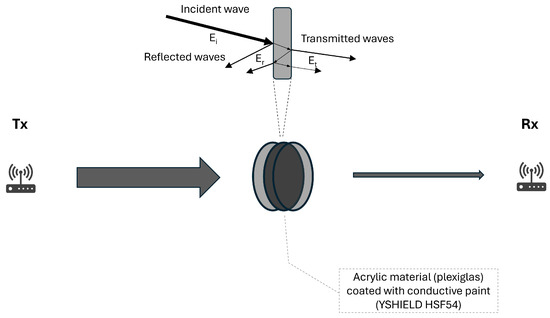
Figure 1.
Transmission of an electromagnetic wave through a multilayer structure: behavior of the electric field strength at the boundary of two media.
Even in environments with electromagnetic interference, such as rooms with echo effects, measurements of reflection parameters provide a comprehensive understanding of the energy redirected by the shield. Consequently, selecting a material with optimal properties—high reflection and absorption combined with minimal transmission—is critical for effective electromagnetic shielding.
3.3. EM Wave Behavior While Passing Through Multilayered Shielding Structures
When an electromagnetic wave encounters a multilayer structure (in our case, several layers of dielectric), such a wave is partially reflected and partially transmitted at each boundary. These reflections and transmissions add up (interfere) and create a complex propagation pattern. Morozov [34] developed a method of multiple reflection that can be applied to multilayer materials. We use this method to calculate the reflection rij and the transmission tij coefficients in multilayer dielectric structures (which is useful in EMI shielding, antennas, filters, radar absorption materials, etc.).
An example of the geometry of the problem is shown in Figure 1 and Figure 2. The length of the dielectric structure is L, and it is bounded by two media whose permittivities are and ( is the complex permittivity). Assuming m layers have complex permittivity of and thickness of d, the following applies [34]:
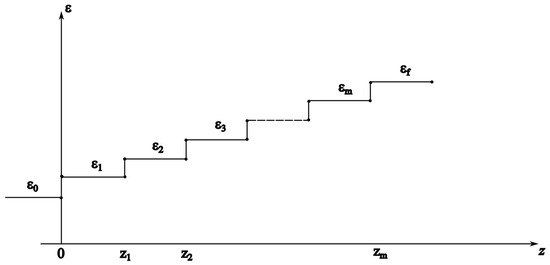
Figure 2.
Permittivity of multilayer structures—z denotes boundaries between layers, while permittivity.
The reflection and transmission coefficients between the layers i and j, and (normal incidence of a wave at the boundary between two media) are represented by the following expressions:
where and represent the impedances of the i-th and j-th layers.
Moroz’s formulas for any number of layers m (first- and second-order approximations) for multiple reflections through all layers are given by the following expression [34]:
According to which the expression for the total transmission through all layers is as follows:
Variable k represents the wave number in expressions (6) and (7). Term in expressions (8) and (9) represents the product of the individual transmission contributions of the layers, while the expression in square brackets describes the mutual interference between the layers (reflections from layers t and p). Terms and represent the reflection coefficients at the right boundary of layer t and the left boundary of layer p, respectively. The exponential term describes the phase difference of waves passing through layers t and p.
According to Morozov [34], the first approximation for total reflection and transmission shows particularly good agreement with real measurement results of the same quantities if the refractive coefficients of all layers have the same values. Since the article addresses the transmission of electric field strength through a multilayer structure, the simulations and measurements results (for each individual case) are verified by using Moroz’s first and second approximations of the transmission parameters and .
4. Simulation and Measurement Setup
The paper focuses on the theoretical calculation and practical measurement of the transmission parameter in a multilayered composite structure combining up to several Plexiglas plates (acrylic, polymethyl methacrylate), a dielectric material, with one or more layers of conductive YSHIELD HSF54 carbon-based paint. A scheme illustrating the measurement setup can be seen in Figure 3—a multilayer structure (varying number of Plexiglass and YSHIELD HSF54 paint) is placed in a circular waveguide. An EM transmitter is placed at one end, while the receiver is located at the opposite end of the circular waveguide. An EM wave passes through the structure, and the transmission parameter is measured by means of simulation and real-world experiments.
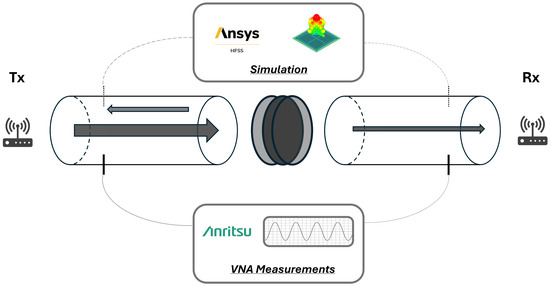
Figure 3.
A scheme for measuring the strength of the electromagnetic wave when passing through the dielectric material (with protective and conductive shield).
The experiments cover two distinct cases, depending on the number of layers of Plexiglass and YSHIELD HSF54 paint. In the first case, the focus was on gradually introducing more Plexiglas plates, each with a single layer of YSHIELD paint. In the second case, only a single Plexiglas plate was present, while we gradually increased the number of paint coating layers.
4.1. Simulation Setup
The simulation was conducted using the ANSYS HFSS program v2.21. Electromagnetic and geometrical parameters used in the simulation for Plexiglas and YSHIELD HSF54 paint are listed in Table 2 and shown in Figure 4. To avoid inaccuracies and to closely mimic the behavior and properties of the real-world materials, we have adjusted the values according to the literature and available technical specifications.

Table 2.
Electromagnetic and geometric parameters of Plexiglas and YSHIELD HSF54 paint used in simulation.
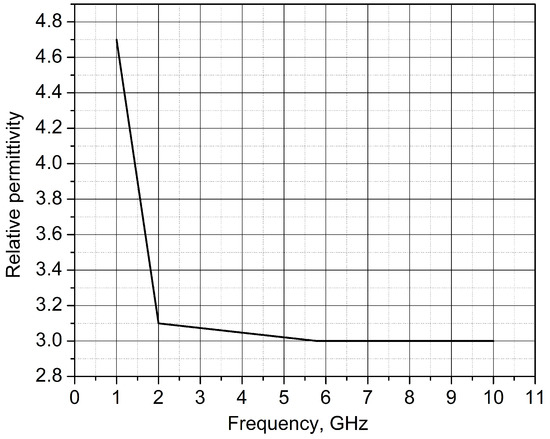
Figure 4.
Simulated Plexiglas relative permittivity as a function of frequency = f(f).
The geometric structure has the following dimensions:
- The waveguide length Lw is 700 mm.
- The waveguide diameter of the inner circular cross-section Dw is 150 mm.
- The waveguide wall thickness Tw is 2 mm.
- The probe length Lp is 52 mm (corresponding frequency range).
- Probe ports 1 and 2 are placed 45 mm away from the waveguide back wall.
- The multilayer structure is located 300 mm from the waveguide wall.
4.2. Measurement Setup
For experimental real-world measurements, we have used the two-port Anritsu MS2038C network analyzer (Anritsu, Kanagawa, Japan) (5 kHz to 20 GHz range) to measure the transmission parameter . The experimental setup, which closely mimics the geometric and EM parameters of the aforementioned simulation, can be observed in Figure 5: a sample Plexiglas disk with a thickness of 4 mm and a diameter of 150 mm, coated with YSHIELD HSF54 carbon-based paint, is inserted into an aluminum waveguide of the same diameter. The experimental setup was carefully crafted to minimize the discrepancies due to differences in measurement conditions compared to an ideal simulation environment:
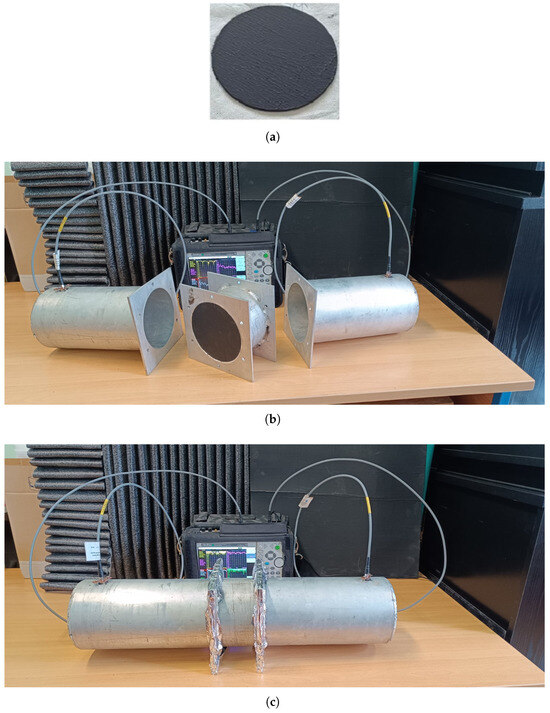
Figure 5.
Experimental measurement setup: (a) Sample Plexiglas disk with YSHIELD HSF54 paint coating; (b) Plexiglas disk in a circular waveguide; (c) Measurement of the transmission parameter in the waveguide when an EM wave passes through.
5. Results of Simulation and Measurement
5.1. Simulation Results: Several Plexiglas Plates, Each with a Single Paint Layer
The first step in our study was to obtain high-quality simulation results of the transmission parameter when the EM wave passes through progressively more Plexiglas plates, each with a single layer of carbon-based coating (YSHIELD paint—Figure 6). For a transmission benchmarking reference, we are using a single Plexiglas plate without a layer of paint (red solid line at the top of Figure 7).
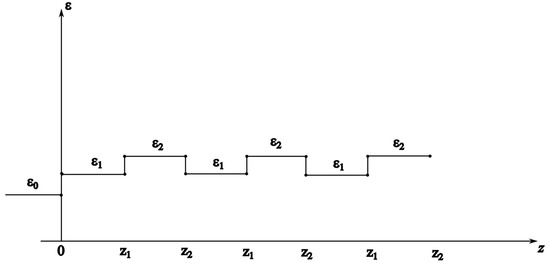
Figure 6.
Permittivity of a multilayer structure—a dielectric plate with one paint coating in series.
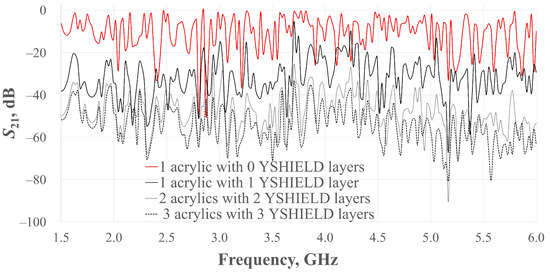
Figure 7.
Simulation results of the transmission parameter when an EM wave passes through one (or more) Plexiglas sheets, each with a layer of YSHIELD HSF54 paint.
Even one coat of YSHIELD HSF54 paint drastically lowers the curve (cf. a difference between the reference red and solid black line. The difference in dB (mean values of the transmission coefficient by layer is −11, −31.74, −48, and −54.63. The simulation results are consistent across a wide frequency range (from 1.5 to 6 GHz). We have also extracted values for several frequencies of interest (frequencies related to 4G LTE and 5GNR mobile networks—cf. Table 3). It also confirms the previous assertions about the drastic attenuation of the field due to the multilayer dielectric structure, particularly in the first layer of the protective coating. Finally, adding more Plexiglas plates, each with YSHIELD HSF54 paint coating, does not appear to have a significantly greater shielding impact compared to a single layer, as observed in the baseline.

Table 3.
parameter at selected 4G LTE and 5GNR frequencies for a case of several Plexiglas plates, each with one coating layer of YSHIELD HSF54 paint.
5.2. Simulation Results: A Single Plexiglas Plate with Several Paint Coating Layers
The second step in our study was to obtain high-quality simulation results of the transmission parameter in a slightly modified multilayer structure: a single Plexiglas plate with progressively more layers of carbon-based coating (YSHIELD paint)—Figure 8. Again, we are using a single Plexiglas plate without a paint coating (red top line in Figure 9) as a transmission benchmarking reference.
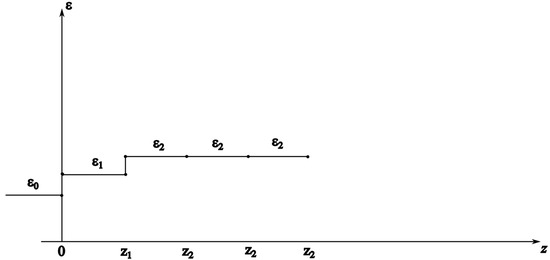
Figure 8.
Permittivity of a multilayer structure—one dielectric plate with one or more paint coatings.
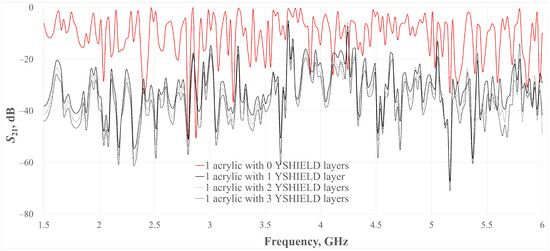
Figure 9.
Simulation results of the transmission parameter when an EM wave passes through a single Plexiglas plate with an increasing number of YSHIELD HSF54 paint coatings.
The simulation results show that the first layer of conductive paint on Plexiglas reduces the transmission parameter the most. Over the full frequency range, it achieves an average 20 dB reduction, lowering the electromagnetic field strength on the receiving side and playing a key role in shielding. Applying further paint layers does not dramatically improve the shielding properties (on average, there is a 3 dB decrease). We have also extracted values for several frequencies of interest (also 1800, 2100, 3400 Hz for 4G LTE and 5GNR mobile networks—cf. Table 4). Similarly to Table 3, Table 4 provides the same conclusion regarding the reduction in attenuation when the number of carbon-based coating layers increases.

Table 4.
parameter at selected 4G LTE and 5GNR frequencies for a case of a single Plexiglas plate with an increasing number of coating layers of YSHIELD HSF54 paint.
Finally, we can observe the statistical variation in data in terms of mean value based on the different multilayered structures.
From the side-by-side comparison of two approaches (see Table 5) when constructing the multilayered structure (left—multiple Plexiglas plates, each with a paint coating layer vs. right—a single Plexiglas plate with several paint coating layers), it appears that paint improves by 3 dB while a full new sandwich layer (Plexiglas and paint) results in an initial 17 dB improvement with the second layer and a 7 dB improvement for a third one. In cases where stringent protection and shielding are needed, investing in additional sandwich layers might be the way forward.

Table 5.
Mean value of parameter for individual cases of geometry in the waveguide.
5.3. Comparative Results Between Experimental Measurements and Simulations
To confirm the validity of our simulation results, we have performed an experimental measurement campaign in the laboratory with an electromagnetic echo and measured the transmission parameter in real-world conditions. The idea was to make sure that the parameters used and the simulated geometrical layout realistically reflected the situation. We need to be aware of a caveat: there will always be discrepancies between the simulation and measurement results, since the laboratory model always differs from the model created in simulation—the measurement conditions, electromagnetic, and geometric parameters of the structure can never be identical. The goal is not to be perfect but close enough that we can confidently confirm the validity of simulated results.
Side-by-side comparative measurements of experiments and simulations for both cases (sandwich and redundant coatings) demonstrate a tight correlation (cf. Figure 10 and Figure 11). The calculated and measured values show close alignment, indicating that the system, including its design, configuration, and implementation, has been effectively executed. This consistency confirms the reliability of the simulation and experimental setup for evaluating electromagnetic shielding performance.
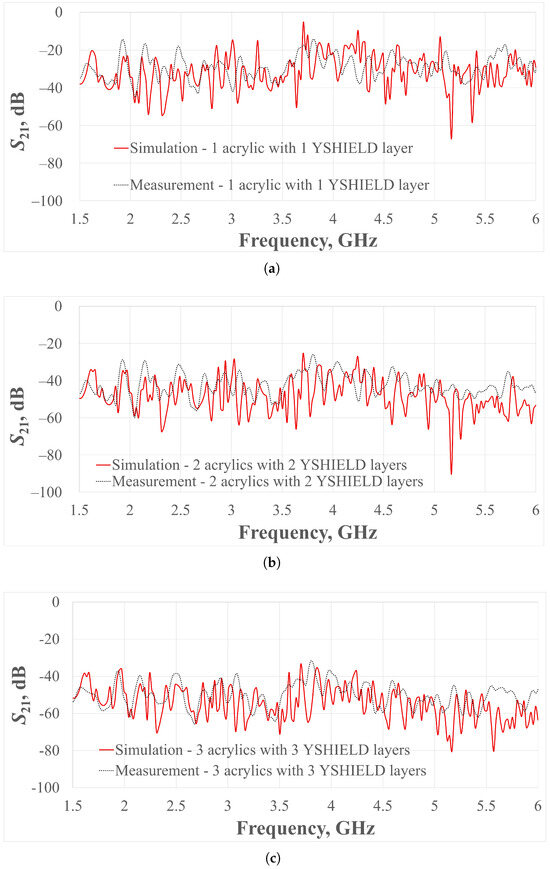
Figure 10.
Transmission parameter (simulation and measurement) when an EM wave passes through a circular acrylic disk to which a single layer of YSHIELD HSF54 paint has been applied: (a) one acrylic with one coat; (b) two acrylics with one coat each; and (c) three acrylics with one coat each.
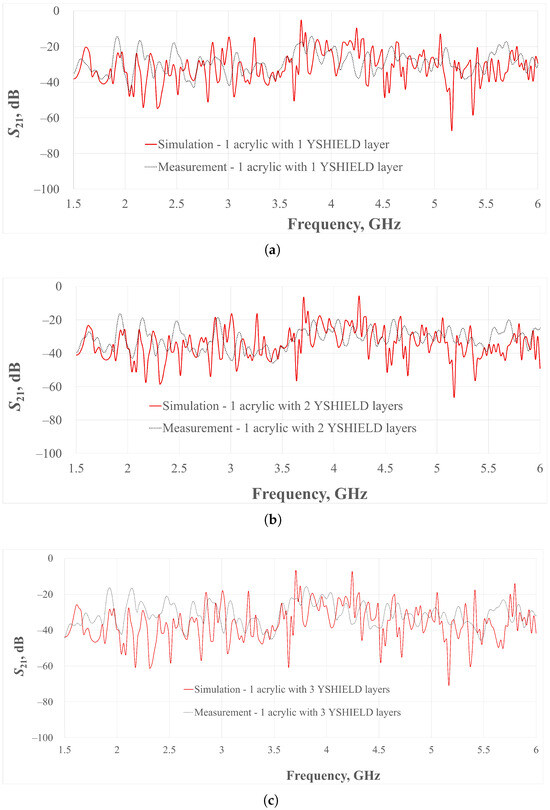
Figure 11.
Transmission parameter (simulation and measurement) when an EM wave passes through a circular acrylic disk to which several layers of YSHIELD HSF54 paint have been applied: (a) one acrylic with one coat; (b) one acrylic with two coats; and (c) one acrylic with three coats.
5.4. Validation of Simulation and Measurement Results Through Morozov’s First- and Second-Order Calculations
The ultimate benchmark for validating both simulation and measurement results is to compare them to the calculated values of the transmission parameter , as given by Morozov’s first and second-order approximations (8) and (9). Figure 12 presents such a visual benchmark, where the calculated, simulated, and measured values of the transmission parameter are compared for a case in which an electric field passes through a multilayer structure placed in a circular-section waveguide.
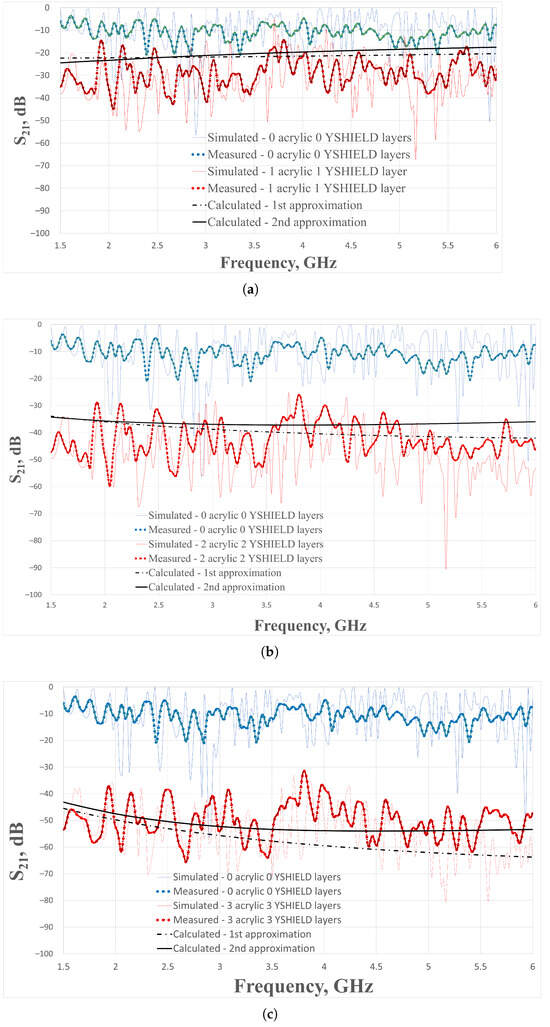
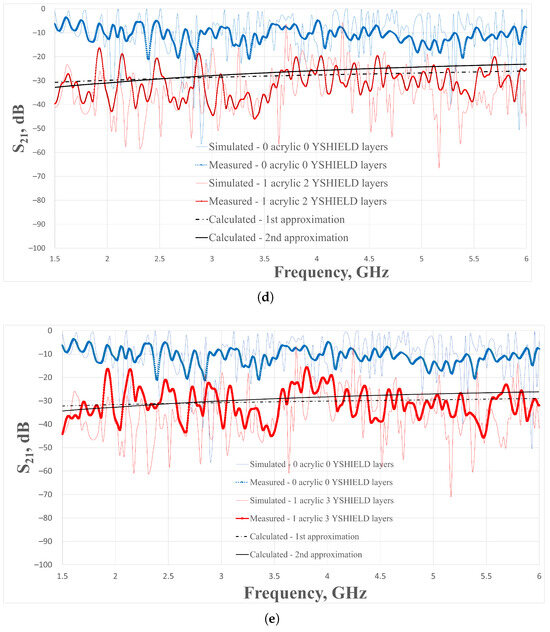
Figure 12.
Validation of simulated and measured values by calculated first- and second-order approximation of the transmission parameter : (a) Sandwich: one layer of conductive paint on one Plexiglass, (b) sandwich: two acrylics with one layer of paint on each; (c) sandwich: three acrylics with one layer of paint on each; (d) redundant: one acrylic with two layers of paint; and (e) redundant: one acrylic with three layers of paint.
All subfigures follow a similar principle, contrasting three distinct results: baseline results (simulated and measured) when there is no obstacle in the waveguide (top blue solid and dashed lines), specific results (one, two, or three layers) for different cases (sandwich or redundant configuration) (red solid and dashed lines), and finally values calculated by Morozov’s first- and second-order approximations (black solid and dashed lines).
Simulations and measurements of the transmission for an empty waveguide and a waveguide containing only Plexiglass (as a substrate for a single or more coats of conductive paint) show very similar values. The results indicate that the first layer of the conductive structure (based on the measured results) reduces the average value of the parameter (across the entire frequency range) by 19 dB. Additionally, the difference between the two minimum values of (with no obstacle in the waveguide and with one layer of conductive paint) is −70 dB.
Figure 12 clearly shows that the simulated and measured values of in all cases agree very well with both the first- and second-order calculations of the parameter according to Morozov. Furthermore, the fact that the second approximation line passes through the centre of the simulated and measured values is a clear validation of the correctness of the entire procedure. Thus, it can be concluded that selecting a carbon-based material is the correct and optimal choice for attenuating EM fields at the observation site.
6. Conclusions
This article provides a study on the potential of using multilayered structures to achieve shielding against EM radiation. It is an approach that is already used as a method of protection in technical devices, and we argue that it can also be used as a protective mechanism for living spaces. By carefully selecting materials and crafting multilayered structures, one can provide effective shielding properties.
We have experimented with the joint usage of Plexiglas plates, a carrier of the absorbent layer, and a carbon-based YSHIELD HSF54 protective paint coating. Our study encompasses two variants in the multilayer structure—the sandwich, with several Plexiglas plates, each coated with a single paint layer, and the redundant package, where a single Plexiglas plate was coated with an increasing number of paint layers.
To evaluate the effectiveness of the shielding, we have considered the fundamental metric—the transmission parameter . The metric was determined by experimental measurement and simulation in the ANSYS HFSS program. To closely match the two approaches, the geometric and EM parameters of the multilayered structure placed in a circular waveguide and the absorber conductive layer were carefully selected to match the literature and available technical specifications. The remaining deviations are due to slight imperfections that occurred while implementing the geometric design of the model (layer thickness, etc.). However, the comparative study of the results shows a closer correlation over the entire wide frequency range of interest (from 1.5 GHz to 6 GHz).
The results unequivocally prove that applying just one layer of YSHIELD HSF54 to a Plexiglas plate can reduce the transmission parameter by over 20 dB (considering the average value of the transmission parameter across the entire measured frequency range). Furthermore, analysis of two scenarios (sandwich and redundancy) involving additional layers in the waveguide clearly shows that a significantly greater contribution to EM field attenuation occurs when a layer of conductive paint is added to the Plexiglas, and this combination of layers is repeated (sandwich). In the sandwich case, the parameter was reduced by more than 16 dB (the difference between the mean values for the first and second layers), while the difference between the second and third layers of the same combination was slightly more than 6 dB. When multiple layers of paint are applied to a single layer of Plexiglas (redundant case), the difference in between the first and second and between the second and third layers of paint is lower. In the redundant case, the difference in the mean value between adjacent layers is less than 5 dB.
The study concludes that shielding using multilayer structures of Plexiglas and conductive carbon-based YSHIELD HSF54 paint can be an effective method of protection against EM radiation in living spaces.
At a time when people are exposed to electromagnetic radiation daily due to the exponential growth of wireless technologies, the need for effective and sustainable solutions to reduce electromagnetic exposure is becoming increasingly important. This work provides a scientific basis for the design of multilayer dielectric barriers that allow control of the transmission and reflection of electromagnetic waves.
Using the method of multiple reflection, our approach provides accurate and scalable calculations for any number of layers, enabling the development of intelligent shielding systems that combine electromagnetic efficiency, aesthetic acceptability, and material sustainability. The proposed shield—Plexiglas coated with YSHIELD HSF54—offers a sustainable, low-cost alternative to commercial options, achieving a 20 dB reduction using widely available materials. Unlike high-performance commercial shields (>80 dB), it emphasizes recyclability and minimal material use, reducing environmental impact. Its simple fabrication process requires little specialized equipment, enabling scalable production for applications that need moderate shielding. Such systems could be used in living and workspaces, industrial facilities, medical and scientific institutions—wherever there is a need to reduce the level of electromagnetic interference without compromising the functionality of the space. In this way, the work not only contributes to the theoretical understanding of propagation through multilayered structures but also paves the way for new, targeted EM shielding solutions that support the health, safety, and technological development of society.
While the present study establishes baseline shielding performance for the single Plexiglas layer (4 mm) combined with a single YSHIELD HSF54 coat (0.08 mm), achieving an average 20 dB reduction, variations in these thicknesses could potentially modulate electromagnetic attenuation due to changes in material density and wave propagation characteristics. Future investigations should explore experimentation on different geometric configurations (layering order, plate thickness, and plate relief) as well as with varied materials to evaluate potential improvements in shielding efficiency, particularly for applications requiring tailored frequency responses. Such parametric studies would necessitate advanced fabrication techniques for precise layer control, representing a valuable extension of this work.
Author Contributions
Idea, conceptualization, methodology, writing, resources, V.M.; Idea, software, supervising, project administration, S.R.; Validation, review, editing, visualization, B.P.; Formal analysis, review, I.B. All authors have read and agreed to the published version of the manuscript.
Funding
This research has been supported by the Ministry of Science, Technological Development and Innovation of Republic of Serbia (Contract No. 451-03-137/2025-03/200156) and the Faculty of Technical Sciences, University of Novi Sad through project “Scientific and Artistic Research Work of Researchers in Teaching and Associate Positions at the Faculty of Technical Sciences, University of Novi Sad 2025” (No. 01-50/295).
Institutional Review Board Statement
Not applicable.
Informed Consent Statement
Not applicable.
Data Availability Statement
The data presented in this study are available on request from the corresponding author due to privacy and ethical restrictions.
Acknowledgments
ChatGPT (https://chatgpt.com/, accessed on 10 October 2025) has been used for purposes such as formatting the text and study design. During the preparation of this manuscript, the authors used ChatGPT, Ansys HFSS v2.21, Inkscape 1.2, and Microsoft Office 15 for the purposes of text formatting, solving problems related to electromagnetism, and drawing figures and graphs separately. The authors have reviewed and edited the output and take full responsibility for the content of this publication.
Conflicts of Interest
The authors declare no conflicts of interest.
References
- International Commission on Non-Ionizing Radiation Protection. ICNIRP guidelines for limiting exposure to time-varying electric, magnetic and electromagnetic fields (up to 300 GHz). Health Phys. 1998, 74, 494–522. [Google Scholar]
- Das, N.C.; Khastgir, D.; Chaki, T.K.; Chakraborty, A. Electromagnetic interference shielding effectiveness of carbon black and carbon fiber filled EVA and NR based composites. Compos. Part A Appl. Sci. Manuf. 2000, 31, 1069–1081. [Google Scholar] [CrossRef]
- Wang, S.Y.; Hung, C.P. Electromagnetic shielding efficiency of the electric field of charcoal from six wood species. J. Wood Sci. 2003, 49, 450–454. [Google Scholar] [CrossRef]
- Folgueras, L.C.; Alves, M.A.; Rezende, M.C. Electromagnetic radiation absorbing paints based on carbonyl iron and polyaniline. In Proceedings of the SBMO/IEEE MTT-S International Microwave and Optoelectronics Conference (IMOC), Belem, Brazil, 3–6 November 2009. [Google Scholar]
- Micheli, D.; Delfini, A.; Santoni, F.; Volpini, F.; Marchetti, M. Measurement of electromagnetic field attenuation by building walls in the mobile phone and satellite navigation frequency bands. IEEE Antennas Wirel. Propag. Lett. 2014, 14, 698–702. [Google Scholar] [CrossRef]
- Yakubu, A.; Abbas, Z.; Hashim, M. Effect of material thickness on attenuation (dB) of PTFE using finite element method at X-band frequency. Adv. Mater. Sci. Eng. 2014, 2014, 965912. [Google Scholar] [CrossRef]
- Chen, Y.; Wang, Y.; Zhang, H.B.; Xiaofeng, L.; Gui, C.X.; Yu, Z.Z. Enhanced electromagnetic interference shielding efficiency of polystyrene/graphene composites with magnetic Fe3O4 nanoparticles. Carbon 2015, 82, 67–76. [Google Scholar] [CrossRef]
- Pan, H.; Yin, X.; Xue, J.; Cheng, L.; Zhang, L. Microstructures and EMI shielding properties of composite ceramics reinforced with carbon nanowires and nanowires-nanotubes hybrid. Ceram. Int. 2017, 43, 12221–12231. [Google Scholar] [CrossRef]
- Chung, D.D.L. Materials for electromagnetic interference shielding. Mater. Chem. Phys. 2020, 255, 123689. [Google Scholar] [CrossRef]
- Liu, T.-T.; Cao, M.-Q.; Fang, Y.-S.; Zhu, Y.-H.; Cao, M.-S. Green building materials lit up by electromagnetic absorption function: A review. J. Mater. Sci. Technol. 2022, 112, 329–344. [Google Scholar] [CrossRef]
- Hu, S.; Wang, D.; Vecernik, J.; Kremenakova, D.; Militky, J.; Petru, M. Sandwich structured carbon fiber composites with enhanced EMI shielding performance. In Proceedings of the 62nd International Conference of Machine Design Departments (ICMD 2022), Liberec, Czech Republic, 13–15 September 2022. [Google Scholar]
- Sajid, H.F.; Afzal, H.; Irfan, M.; Saleem, M.; Jan, R.; Javed, S.; Akram, M.A. Design of Multilayered 2D Nanomaterial Composite Structures for EMI Shielding Analysis. ACS Omega 2022, 7, 35586–35594. [Google Scholar] [CrossRef] [PubMed]
- Kwon, D.J.; Kwon, I.J.; Milam-Guerrero, J.; Yang, S.B.; Yeum, J.H.; Choi, H.H. Aramid nanofiber-reinforced multilayer electromagnetic-interference (EMI) shielding composites with high interfacial durability. Mater. Des. 2022, 215, 110452. [Google Scholar] [CrossRef]
- Guo, B.; Liang, J.; Chen, J.; Zhao, Y. Highly flexible and ultrathin electromagnetic-interference-shielding film with a sandwich structure based on PTFE@Cu and Ni@PVDF nanocomposite materials. RSC Adv. 2022, 12, 29688–29696. [Google Scholar] [CrossRef] [PubMed]
- Budumuru, S.; Rao, S.S.; Jenjeti, D.; Aparao, T.V.S. Shielding effectiveness of multilayer laminate of aluminum metal matrix and micro absorbing materials. MethodsX 2023, 10, 102172. [Google Scholar] [CrossRef]
- Horim, L.; Ryu, S.H.; Kwon, S.J.; Choi, J.R.; Lee, S.B.; Park, B. Absorption-Dominant mmWave EMI Shielding Films with Ultralow Reflection using Ferromagnetic Resonance Frequency Tunable M-Type Ferrites. Nano-Micro Lett. 2023, 15, 76. [Google Scholar]
- Mikołajczyk, Z.; Nowak, I.; Januszkiewicz, L.; Szewczyk, M.; Junak, J. Modern Electromagnetic-Radiation-Shielding Materials Made Using Different Knitting Techniques. Materials 2024, 17, 3052. [Google Scholar] [CrossRef]
- Li, X.; Zeng, B.; Zheng, Y.; Zhou, J. Excellent mechanical and electromagnetic interference shielding properties of polylactic acid/polycaprolactone/multiwalled carbon nanotube composites enabled by a multilayer structure design. RSC Adv. 2024, 14, 20390–20397. [Google Scholar] [CrossRef]
- Lv, X.; Yang, Q.; Ding, Y.; Liu, J.; Zong, J.; Zang, X.; Wang, X.; Li, S. Multilayer composites containing anisotropic structured aerogels: A strategy for enhancing the electromagnetic shielding absorption mechanism and achieving multi-functional integration. J. Mater. Chem. A 2025, 17, 1–18. [Google Scholar] [CrossRef]
- Khade, V.; Thirumalasetty, A.B.; Choukiker, Y.K.; Liu, J.; Zong, J.; Wuppulluri, M. A cost-effective strategy to design and fabricate absorption dominant flexible multilayer laminates by rationally tailoring their layers. Mater. Adv. 2024, 5, 8889–8900. [Google Scholar] [CrossRef]
- Chen, Z.; Yang, S.; Huang, J.; Gu, Y.; Huang, W.; Liu, S.; Lin, Z.; Zeng, Z.; Hu, Y.; Chen, Z.; et al. Flexible, Transparent and Conductive Metal Mesh Films with Ultra-High FoM for Stretchable Heating and Electromagnetic Interference Shielding. Nano-Micro Lett. 2024, 16, 92. [Google Scholar] [CrossRef] [PubMed]
- Hu, S.; Wang, D.; Vecernik, J.; Kremenakova, D.; Militky, J. Electromagnetic Interference (EMI) Shielding and Thermal Management of Sandwich-Structured Carbon Fiber-Reinforced Composite (CFRC) for Electric Vehicle Battery Casings. Polymers 2024, 16, 2291. [Google Scholar] [CrossRef]
- Liu, X.; Huang, H.; Lu, H. Preparation, structure and properties of epoxy/carbonyl iron powder wave-absorbing foam for electromagnetic shielding. Polymers 2024, 16, 698. [Google Scholar] [CrossRef] [PubMed]
- Naqvi, S.M.; Hassan, T.; Iqbal, A.; Zaman, S.; Cho, S.; Hussain, N.; Kong, X.; Khalid, Z.; Hao, Z.; Koo, C.M. Comparative Electromagnetic Shielding Performance of Ti3C2Tx–PVA Composites in Various Structural Forms: Compact Films, Hydrogels, and Aerogels. Nanoscale 2025, 17, 8563–8576. [Google Scholar] [CrossRef]
- Pan, Y.; Dai, M.; Guo, Q.; Yang, D.; Yin, D.; Hu, S.; Qiu, F.; Wang, Y.; Xue, Z. High-efficiency electromagnetic shielding of three-dimensional laminated wood/Cu/Ni composites. Colloids Surf. A Physicochem. Eng. Asp. 2024, 697, 133456. [Google Scholar] [CrossRef]
- Nguyen, Q.-D.; Choi, C.-G. Recent advances in multifunctional electromagnetic interference shielding materials. Heliyon 2024, 10, e23456. [Google Scholar] [CrossRef]
- Cellozi, S.; Araneo, R.; Lovat, G. Electromagnetic Shielding, 1st ed.; John Wiley & Sons, Inc.: Hoboken, NJ, USA, 2008. [Google Scholar]
- Arjmand, M.; Mahmoodi, M.; Gelves, G.A.; Park, S.; Sundararaj, U. Electrical and electromagnetic interference shielding properties of flow-induced oriented carbon nanotubes in polycarbonate. Carbon 2011, 49, 3430–3440. [Google Scholar] [CrossRef]
- Wang, G.; Liao, X.; Yang, J.; Tang, W.; Zhang, Y.; Jiang, Q.; Li, G. Frequency-selective and tunable electromagnetic shielding effectiveness via the sandwich structure of silicone rubber/graphene composite. Compos. Sci. Technol. 2019, 184, 107850. [Google Scholar] [CrossRef]
- Liang, L.; Xu, P.; Wang, Y.; Shang, Y.; Ma, J.; Su, F.; Feng, Y.; He, C.; Wang, Y.; Liu, C. Flexible polyvinylidene fluoride film with alternating oriented graphene/Ni nanochains for electromagnetic interference shielding and thermal management. Chem. Eng. J. 2020, 395, 125078. [Google Scholar] [CrossRef]
- Zhao, B.; Wang, S.; Zhao, C.; Li, R.; Hamidinejad, S.M.; Kazemi, Y.; Park, C.B. Synergism between carbon materials and Ni chains in flexible poly(vinylidene fluoride) composite films with high heat dissipation to improve electromagnetic shielding properties. Carbon 2018, 127, 469–478. [Google Scholar] [CrossRef]
- Singh, A.P.; Garg, P.; Alam, F.; Singh, K.; Mathur, R.B.; Tandon, R.P.; Chandra, A.; Dhawan, S.K. Phenolic resin-based composite sheets filled with mixtures of reduced graphene oxide, γ-Fe2O3, and carbon fibers for excellent electromagnetic interference shielding in the X-band. Carbon 2012, 50, 3868–3875. [Google Scholar] [CrossRef]
- Lin, J.H.; Lin, Z.I.; Pan, Y.J.; Huang, C.L.; Chen, C.K.; Lou, C.W. Polymer composites made of multi-walled carbon nanotubes and graphene nano-sheets: Effects of sandwich structures on their electromagnetic interference shielding effectiveness. Compos. Part B Eng. 2016, 89, 424–431. [Google Scholar] [CrossRef]
- Morozov, G.V.; Maev, R.G.; Drake, G.W.F. Multiple reflection method for electromagnetic waves in layered dielectric structures. Quantum Electron. 2001, 31, 767–773. [Google Scholar] [CrossRef]
Disclaimer/Publisher’s Note: The statements, opinions and data contained in all publications are solely those of the individual author(s) and contributor(s) and not of MDPI and/or the editor(s). MDPI and/or the editor(s) disclaim responsibility for any injury to people or property resulting from any ideas, methods, instructions or products referred to in the content. |
© 2025 by the authors. Licensee MDPI, Basel, Switzerland. This article is an open access article distributed under the terms and conditions of the Creative Commons Attribution (CC BY) license (https://creativecommons.org/licenses/by/4.0/).